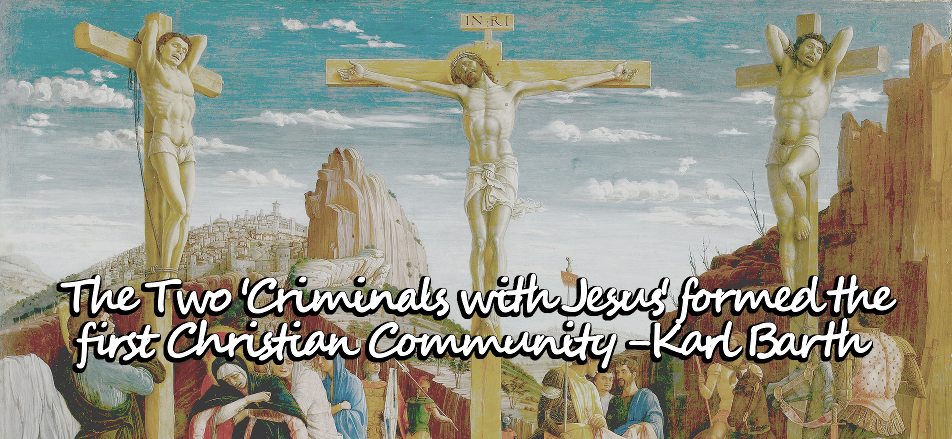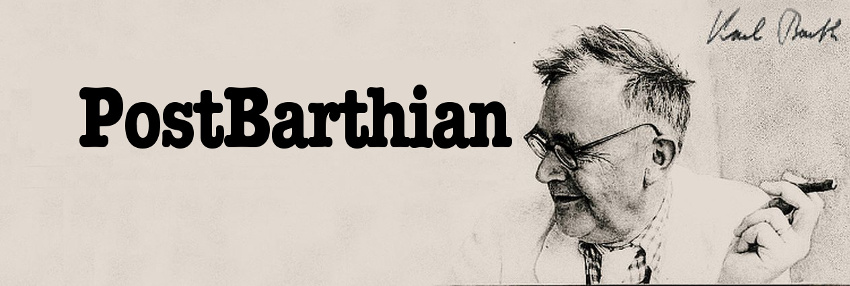
Update 2019-04-17: For a revised and updated version of this post read: Karl Barth on Good Friday: the criminals crucified with Jesus formed the first Christian community
Karl Barth often preached to the Basel city prisoners at the end of his life, and these sermons were published in a collection titled: Deliverance to the Captives. On Good Friday in 1957, Karl Barth preached an outstanding sermon on the criminals crucified with Jesus (included in this collection) titled: "Criminals With Him" (Luke 23:33). I've provided several longer quotations from Barth's Criminals With Him that properly explains that these two criminals on crosses to the left and right of Jesus form the first Christian community. These criminals, against their will, are raised up publicly with Jesus, and regardless of their personal opinions, and whether they 'accept Jesus' or not, they are with Jesus and have taken up their cross with Him. These two criminals are the two who are on the left and right of Jesus as he comes into his kingdom (cf. Matthew 20:23).
Criminals With Him
My dear brothers and sisters, I should like to invite you, before I begin my sermon, to read for yourselves the story of Good Friday, the story of the suffering and death of Jesus Christ, as it is recorded in the four Gospels. Why don't you read it today and again and again? If we meditate and understand it rightly, this story contains the whole history of the world and, what is more, of God's dealing with man and hence of our dealings with God, including the life history of each of us here. I would need more than a half-hour were I to give an adequate summary of this history, let alone an insight into its complexity. Let me therefore select just one sentence for our meditation together. It is written in Luke 23:33:
They crucified him with the criminals, one on either side of him.
'They crucified him with the criminals'. Which is more amazing, to find Jesus in such bad company, or to find the criminals in such good company? As a matter of fact, both are true! One thing is certain: here they hang all three, Jesus and the criminals, one at the right and one at the left, all three exposed to the same public abuse, to the same interminable pain, to the same slow and irrevocable death throes. Like Jesus, these two criminals had been arrested somewhere, locked up and sentenced by some judge in the course of the previous few days. And now they hang on their crosses with him and find themselves in solidarity and fellowship with him. They are linked in a common bondage never again to be broken, just as the nails that fastened them to the piece of wood would never break. It was as inescapable for them as it was for him. It was a point of no return for them as for him. There remained only the shameful, pain stricken present and the future of their approaching death. (Strangely enough, there are many paintings of Jesus' crucifixion were the two criminals are lost to sight. It would perhaps be more appropriate not to represent Jesus' death at all. But if it is done, then the two thieves on the right and on the left must not be left out. In any painting or representation where they are absent, an important, even an essential, element is missing.)
They crucified him with the criminals. Do you know what this implies? Don't be too surprised if I tell you that this was the first Christian fellowship, the first certain, indissoluble and indestructible Christian community. Christian community is manifest wherever there is a group of people close to Jesus who are with him in such a way that they are directly and unambiguously affected by his promise and assurance. These may hear that everything he is, he is for them, and everything he does, he does for them. To live by this promise is to be a Christian community. The two criminals were the first certain Christian community.
[. . .]
The two criminals who at this hour were crucified with him had probably never heard of him before and were certainly no believing converts, no saints. Far from it! The opposite is true! But in this hour they could not abandon him, they could not sleep. Willingly or not, they were forced to watch with him many long hours on the cross. Nor could they escape his dangerous company. They could not very well deny him, being publicly exposed as his companions. This is how they were in fact the first certain Christian community! He and they, they and he were bound together, were not and are not to be separated in all eternity. Great things had to pass before Peter and the rest of the disciples joined this first Christian community. And when they did so, they could only 'get in line behind' the two criminals who were already first, and up there in front, with Jesus on Golgotha.
[. . .]
Let us now go back to the two criminals who were crucified with Jesus according to God's will and deed. We do not know their names. We know nothing about their lives, of their misdoings and crimes. We do not know whether they could plead attenuating circumstances, or whether their guilt was even greater than we may think. We only know that the thieves were condemned, 'receiving', as one of them admitted, 'the due reward of our deeds'. We know above all that, without their consent and against their wishes, they were in fact crucified with him, with Jesus. No one before and no one afterwards has witnessed so directly and so closely God's act of reconciliation, God's glory and the redemption of the world, as these two thieves. True, only one of them acknowledged who Jesus was and what he did in his suffering and death for all men--the their not excluded. His companion, as it is later recorded in the Gospels, shared in the general, blind and hollow mockery. Why did he not, if he was really the Christ, the Son of God, help himself and them? This is certainly an important and notable difference between the two criminals. But we shall not dwell on it today. For the difference is not important enough to invalidate the promise given so clearly, so urgently to both of them, indeed without distinction.
Consider the fact: Jesus died precisely for these two criminals who were crucified on his right and on his left and went to their death with him. He did not die for the sake of the good world, he died for the sake of an evil world, not for the pious, but for the godless, not for the just, but for the unjust, for the deliverance, the victory and the joy of all, that they might have life. These two companions were evidently and undeniably criminals, evil people, god-less people, unjust people. And he, like them, was condemned and crucified as a law-breaker, a criminal. All three were under the same verdict.
[. . .]
And now, dear friends, we are not asked in the least if we want to be such people, thank God. We are such people, all of us--you in this house which is called a prison, with all the burden that brought you here and with your particular experiences in this place--those others of us outside who have different experiences and yet are, believe me, in the same predicament. In reality we all are these people, these crucified criminals. And only one thing matters now. Are we ready to be told what we are? Are we ready to hear the promise given to the condemned, to 'get in line behind'? 'God opposes the proud, but gives grace to the humble.' Those receive the promise who regard themselves as neither so exalted nor so debased that they cannot 'get in line behind' the two criminals who were first on Golgotha. May God give us all the grace to do so! May he help us to use this grace rightly! May he bless us all as we in this freedom go to his table now! Amen.
Barth, Karl. Deliverance to the Captives. "Criminals With Him". Trans. M. Wieser. New York: Harper & Row, 1961. 75-84. Print.
"Mantegna, Andrea - crucifixion - Louvre from Predella San Zeno Altarpiece Verona" by Andrea Mantegna - The Yorck Project: 10.000 Meisterwerke der Malerei. DVD-ROM, 2002. ISBN 3936122202. Distributed by DIRECTMEDIA Publishing GmbH.. Licensed under Public Domain via Wikimedia Commons.



April 29th, 2015 - 14:46
I need to read this book. Such a simple yet deep sermon. The proclamation of the gospel must be easily understandable & it must reach our innermost being.
Thanks, Wyatt!
March 30th, 2018 - 21:13
Reading this, it occurred to me that Jesus’ crucifixion in some ways is opposite in spirit from the Genesis Flood. In the flood, the wicked die while on Noah’s ark, the righteous are saved. In the crucifixion the righteous [one] dies while the guilty are set free. Following the flood, God pledges never to permit a universal punishment to destroy the world. In the crucifixion, that promise is kept. God’s judgment is focused on a single person rather than on the whole sinning, covenant-breaking world. Interesting post. Thank you.
March 31st, 2018 - 08:37
You’re right. You can see this theme in Young Earth Creationism, where the insistence of a global flood is paired with a theology of a vengeful god intent on destroying the world and the righteous survive by being locked within the ark encounter.